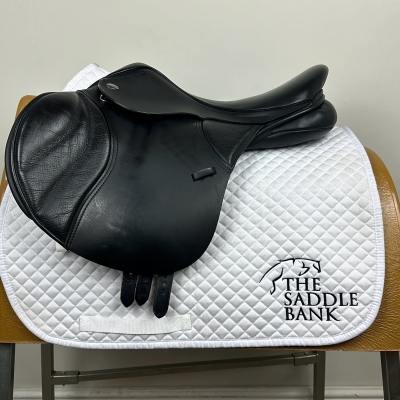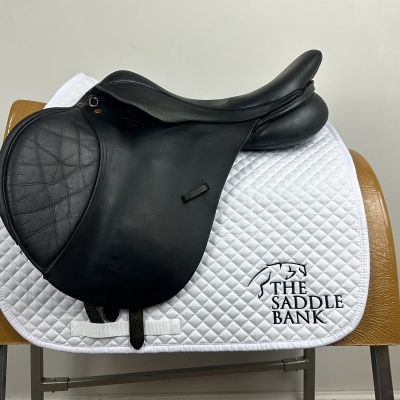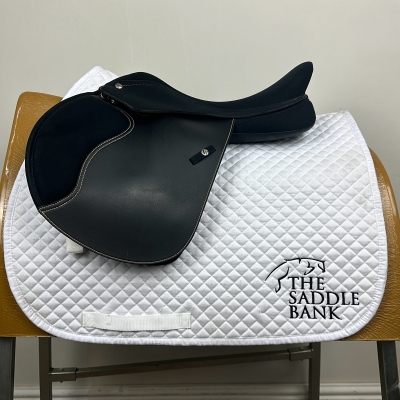Jump saddles for sale
Quick Links
All Jump Saddles
Cob Jump Saddles
Pony Jump Saddles
Monoflap Jump Saddles
European Brands of Jump Saddle
Jump Saddles Under £500
17 inch Thorowgood T8 Jump MJJ Black Adjustable (S6461)
Used
17 inch
Adjustable
Black
£
399
.00
View saddle
17.5 inch Kent and Masters Original Jump MJU Black Adjustable (S6240)
Used
17.5 inch
Adjustable
Black
£
399
.00
View saddle
16 inch Wintec Pro Pony Jump Black Adjustable (S5630)
Used
16 inch
Adjustable
Black
£
500
.00
View saddle
When looking for a jump saddle on a budget, it is important to consider your horse's needs over price. A huge selection of competitively priced jump saddles is available on the market. However, the fit for your horse should not be compromised. When selecting a jump saddle, you should consider the following;
• the wither profile of your horse (medium, high or low)
• the back shape of your horse (average, flat, curved)
• the back length of your horse (many people ride in saddles too long for their horse and cause the horse pain)
• the current and expected condition of the horse (does the horse have any muscle wastage, and is the horse likely to regain the muscle or is it due to age)
• position of the girth groove (is the girth groove forward/average)
• any other conformation issues (herring gutted/roach backed etc.)
Jump saddles enable the rider to shorten their stirrup leathers to stand up from their stirrups over the fence to enable the horse to clear the jump. When shortening the stirrups, the rider's knee will naturally sit further forward. As a result the flap on jump saddles has to be more forward cut to accommodate this. Jump saddles are typically flatter through the seat for less interference over fences, enabling the rider to return to a neutral position after landing. Knee blocks on jump saddles vary depending on the rider's preference, ability and level of support required. Jump saddles are available as either monoflap or dual-flap options. In the UK, we tend to find eventers opting for monoflap jump saddles and show jumpers dual flaps. However, this is just personal preference, and certainly no hard or fast rule as to which you should have. Monoflap jump saddles will feature external knee blocks for support. Whereas dual flap jump saddles feature a knee block under the main flap. This may be fixed or velcro, depending on the brand and model. Many jump saddles also offer a back block, which can help prevent the leg from coming too far back, ensuring the rider maintains the optimum position. If using a monoflap jump saddle, you will need an appropriately sized short girth, which should not interfere with the horse's elbow and allow them freedom of movement. However, monoflap jump saddles tend to be more expensive than dual-flap options. Therefore, if you are looking for a jump saddle priced under £500, it is likely that you will end up with a dual flap jump saddle.
Jump saddles that are slightly deeper in the seat and offer a larger knee block are aimed at riders who prefer a little bit more support in the saddle. The Black Country Wexford, Albion K2 Jump, Wintec 500 Jump, and Monarch VSJ are all examples of saddles that would suit this type of rider. For more serious competition riders, flatter-seated saddles typically work better. Examples include the Ideal Impala, Wintec Close Contact, Monarch Jump, and Kent and Masters MJU Original Jump saddle.
In terms of fit for the horse, due to the various brands available on the market, there are many different options, enabling riders to have a fantastic amount of choice in getting the right saddle for horse and rider. Firstly, consider the type of panel that would work best for your horse. Panel options include traditional wool flock, foam panels, and CAIR cushion panels, as found in the Bates/Wintec/Arena saddles. The shape of the panel is also important in terms of the horse's conformation and back profile. Some saddles offer exceptionally close contact, slimline panels. Whereas others offer a more generous drop panel. Different saddles are also fitted with different trees to suit different conformation profiles, such as flatter-backed horses, horses with a slight curve in the back, or wider cobbier types who may need a broader tree. You should also consider whether you want an adjustable gullet saddle or a fixed tree. Consider the age of your horse and how frequently they change shape. Some horses drop off in the winter and regain condition in the spring/summer. For these horses, an adjustable gullet jump saddle may work best. Similarly, young horses naturally change shape as they grow and develop, so an adjustable gullet jump saddle may work well. If your horse is of mature age, in regular work, with little changes to their diet/grazing and workload, a fixed tree saddle may also work well for you.
Many popular brands and models of jump saddles are available in the market. Some of the best low-budget jump saddles include the Wintec 500 Jump, Wintec Close Contact Jump, Thorowgood Jump Saddle, Kent and Masters Jump saddle, Cavaletti Collection Jump saddle, and some older quality leather saddles such as Jeffries, Ideal and Albion. Whatever your budget, The Saddle Bank has a fantastic selection of jump saddles available to purchase with a 5-day UK trial.








